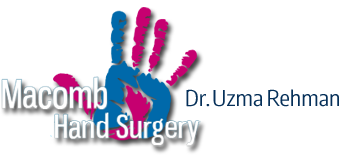How Hand Doctors Treat Ganglion Cysts
If you are experiencing unexplained bumps on your hands or wrists, you may be suffering from ganglion cysts. Bloomfield Hills board certified hand doctor Uzma Rehman has helped hundreds of patients get relief from this painful condition of the hand and wrist.
In this article we discuss the non-surgical and surgical treatments offered by hand doctors to treat ganglion cysts.
What Are Ganglion Cysts?
Ganglion cysts are a common condition involving a fluid-filled sac on the hand or wrist that bulges up. They can appear quickly, and disappear just as quickly. But sometimes the cysts remain, and are unsightly or cause impaired function or pain in the hand or wrists.
Ganglion cysts are common benign soft tissue masses, with prevalence rates varying across different populations. According to a study published in the Journal of Hand Surgery, ganglion cysts are estimated to occur in approximately 0.6% to 1.2% of the general population1. They are more prevalent among women than men and typically affect individuals between the ages of 20 and 40. Ganglion cysts are frequently found in the wrist and hand, but they can also develop in other locations such as the ankle, knee, and foot.
Risk Factors for Ganglion Cysts
While ganglion cysts can occur in anyone, certain factors may increase the likelihood of developing them. Individuals who engage in repetitive activities or experience joint stress and trauma are more prone to developing ganglion cysts. Therefore, athletes, musicians, and individuals with occupations involving repetitive wrist or joint movements may be at higher risk. Additionally, those with underlying joint conditions such as osteoarthritis or ligament injuries may also be predisposed to developing ganglion cysts.
What Causes Ganglion Cysts?
Hand doctors are still not certain why ganglion cysts develop. One theory posits that they are caused by repetitive motion of the hand or wrist. Gymnasts have been noted to experience the problem more frequently, due to the extra stress and pressure on their hands and wrists.
But while the exact cause of ganglion cysts remains unclear, recent research has shed light on potential contributing factors. One prevailing theory suggests that ganglion cysts develop as a result of joint or tendon trauma, leading to the leakage of synovial fluid into surrounding tissues and the formation of a cystic structure. However, recent studies have also implicated genetic predisposition and alterations in joint mechanics as possible factors contributing to the development of ganglion cysts. Further research is needed to elucidate the underlying mechanisms and risk factors associated with ganglion cyst formation.
How to Hand Doctors Treat Ganglion Cysts?
Initially, hand doctors will usually offer treatment for ganglion cysts that is non-invasive. Treatment may involve the use of wrist splints to immobilize the hand, thus allowing the overworked area to rest. Sometimes this can reduce the cyst.
If the cyst is quite bothersome or painful, an aspiration (“draining”) procedure may be performed by the hand doctor. In this procedure, the affected area is numbed and a needle is inserted into the fluid-filled cyst, withdrawing the fluid. This can relieve the pressure that may have been placed on nerves or tendons, causing the tingling or pain in the hand or wrist. If the cyst grows back, sometimes this procedure can be repeated by the hand doctor with success.
Recent advancements in minimally invasive techniques, such as ultrasound-guided aspiration and cyst rupture, have shown promising results in the management of ganglion cysts. These approaches offer improved precision and reduced risk of recurrence compared to traditional aspiration methods. Additionally, intralesional injection therapies, including corticosteroids or sclerosing agents, have been explored as alternative treatment modalities for ganglion cysts, with some studies reporting favorable outcomes in terms of symptom relief and cyst regression.
Surgical Treatment for Ganglion Cysts
If the cyst does not respond to the non-invasive procedures and continues to be painful, your hand doctor may recommend a surgical procedure. In this case a board certified orthopedic surgeon such as Dr. Rehman can perform a procedure to remove the ganglion and its root.
Ganglion cysts surgery is typically an outpatient procedure, and the patient can go home the same day. Splints and dressings are typically required, and often Occupation Therapy is prescribed by the hand doctor to return full strength and range of motion to the hand and wrist.
Because the structure of the hands and wrists is so delicate, it is important to have a board certified hand doctor, such as a Bloomfield Hills surgeon Dr. Rehman, perform this procedure.
Top Hand Doctor Bloomfield Hills
Ganglion cysts are common soft tissue masses that can affect individuals of all ages and demographics. While the exact etiology of ganglion cysts remains uncertain, recent research has provided valuable insights into potential risk factors and underlying mechanisms. Advanced treatment options, including minimally invasive procedures and intralesional injections, offer promising alternatives for the management of ganglion cysts, emphasizing the importance of individualized care and multidisciplinary approaches in addressing this prevalent condition.
If you think you may be suffering from a ganglion cyst, or any other injury or illness of the hand fingers or wrist, contact Bloomfield Hills board certified hand doctor, Dr. Rehman for a comprehensive evaluation and consultation. As with most medical conditions, early detection, awareness, and a prevention or treatment plan is the most effective way to combat the effects of ganglion cysts, and other conditions of the hand and wrist.
Bloomfield Hills Hand Doctor: 248.940.5233
..
Sources:
[1] Bui-Mansfield LT, Youngberg RA, Warme WJ, Pitcher JD. “Frequency of ganglionic cysts originating from the proximal tibiofibular joint: initial observations with US.” Radiology. 2004 Oct;233(1):260-4. doi: 10.1148/radiol.2331030861. PMID: 15333767.

